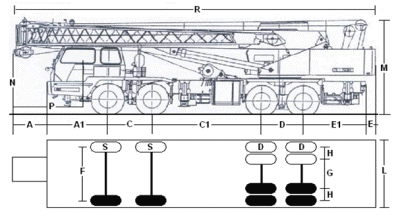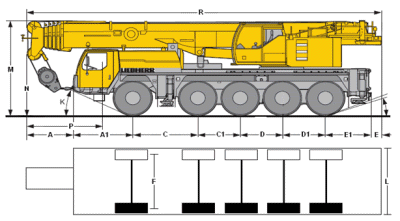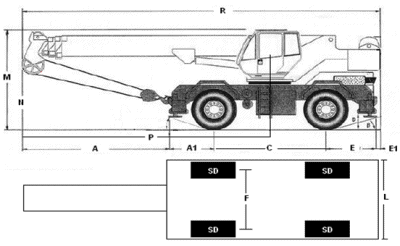MOBILE CRANES
MOBILE CRANES
Truck / Center Mounted and All Terrain Cranes
Although the Road Traffic Act and TRH 11 does not distinguish between different types of mobile cranes it is known in the industry that there are Truck Mount, All Terrain and Centre Mount cranes.
A TYPICAL EXAMPLE OF A TRUCK MOUNTED MOBILE CRANE

A TYPICAL EXAMPLE OF A ALL TERRAIN MOBILE CRANE

A TYPICAL EXAMPLE OF A CENTRE MOUNTED MOBILE CRANE

The legal dimensions and mass for these vehicles are as follows:
LENGTH 12 500mm
WIDTH 2600mm
HEIGHT 4300mm
FRONT OVERHANG A+A1
Measured from the centre of the front axle to the tip of the boom.
(i) For vehicles where the distance from the front end of the vehicle to the backrest of the driver's seat at seat-level is less than 1700mm, to the lesser of - 60 % of the wheelbase, or (refer "P" as per diagram) 6200mm less half the wheelbase.
(ii) where this distance is more than 1700mm, to the lesser of - 60 % of the wheelbase, or 5800mm less half the wheelbase.
REAR OVERHANG E+E1
Measured from the centre of the rear most axle to the rear most point.
The legal masses for a mobile crane is similar to any goods vehicle i.e.:
a) SINGLE STEERING AXLE 7700kg
b) SINGLE DRIVE OR NON STEERING AXLE 8000kg
c) DUAL DRIVE OR NON STEERING AXLE 9000kg
Other factors which may influence any of the figures given in a, b or c above
(i) the manufacturers rating of an axle
(ii) Tyre manufacturers rating The lesser will always apply
(iii) Nett kilowatt or Engine power
• This information will be supplied on request:
LIMITATION IMPOSED BY BRIDGES AND CULVERTS (Quotes from the Road Traffic Act - summarized) Although it is the road pavement which limits the allowable load that may be carried by combinations of two or more axles, these limits are determent by the design and present conditions of the structure, and by the wheel configuration of the vehicle.
The restrictions that have been set for groups of axles are as follows: (bridge formula)
Regulations stipulate that the maximum legal mass load in kilograms on a group of axles may not exceed the value based on the formula:
TOTAL AXLE MASS LOAD OF GROUP OF CONSECUTIVE AXLES = 18000+2100xL
Where L is the distance between centre lines of extreme axles in meters (to the next highest tenth of a meter)
POWER / MASS RATIO
Allowable gross vehicle mass shall not exceed a figure arrived at by multiplying the net power at sea-level delivered to the transmission of the vehicle by 240.
MASS LOAD ON DRIVING AXLES
To ensure sufficient traction, a minimum ratio of mass load on driving axles to total vehicle mass load is specified.
Regulation states that the mass load carried on the driving axles shall be no less than 20% of the gross mass of the vehicle.
MASS LOAD ON STEERING AXLES
To ensure steer ability.
Regulation states that:
a) in the case of a mobile crane and similar vehicles with a steering axle unit(more than one steering axle) the sum of the axle mass loads of such steering axle unit is no less than 30% of the sum of all axle mass loads of such vehicle.
b) in the case of a mobile crane and similar vehicles with one steering axle only, the axle mass load of a steering axle is no less than 20% of the sum of all axle mass loads of such vehicle.
Allowable "under permit"
Dimensions and mass "under permit" are controlled by parameters laid down by various factors as stipulated in the TRH 11. For clarification please do not hesitate to contact us.
• Foundation Diggers, Drilling Rigs and other similar vehicles are also classified under this category in terms of the TRH 11.

